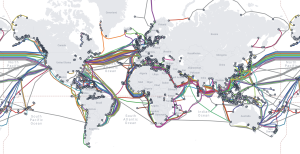Starlink: Revolutionizing Global Connectivity with Satellite Internet
Starlink is a satellite internet constellation developed by SpaceX, a private aerospace manufacturer and space transport services company founded by Elon Musk. The project aims to provide high-speed, low-latency internet connectivity worldwide, especially in areas where traditional fiber-optic cables are not feasible or available. With its cutting-edge technology and innovative approach, Starlink is poised to revolutionize the way we access the internet.
At the beginning of the Starlink project, the focus was on creating a network of low-Earth orbit (LEO) satellites that can provide fast and reliable internet connectivity to users across the globe. The company launched its first batch of satellites in 2019 and has since expanded its constellation to include thousands of satellites. Each satellite is equipped with advanced technology, including Hall effect thrusters, star trackers, and a compact antenna system, enabling them to communicate with each other and with ground stations.
Features and Benefits of Starlink
Starlink offers several features and benefits that make it an attractive option for users seeking high-speed internet connectivity. Some of the key advantages include low latency, high speeds, and global coverage. With its LEO satellites, Starlink can provide latency as low as 20 ms, which is comparable to traditional fiber-optic cables. Additionally, the network offers speeds of up to 1 Gbps, making it suitable for applications such as online gaming, video streaming, and cloud computing.
Another significant benefit of Starlink is its ability to provide internet connectivity in areas where traditional infrastructure is not available. This includes remote and rural areas, as well as regions affected by natural disasters or conflict. By providing a reliable and fast internet connection, Starlink can help bridge the digital divide and enable access to essential services such as education, healthcare, and emergency services.
Impact on Global Connectivity
The impact of Starlink on global connectivity cannot be overstated. With its ability to provide high-speed internet connectivity to anyone, anywhere in the world, Starlink has the potential to revolutionize the way we communicate, work, and access information. The network can also enable new use cases such as IoT (Internet of Things), smart cities, and autonomous vehicles, which require low-latency and high-speed connectivity.
Furthermore, Starlink can help address the growing demand for internet connectivity in emerging markets. According to the International Telecommunication Union (ITU), there are still over 3.8 billion people worldwide who lack access to the internet. By providing a reliable and affordable internet connection, Starlink can help bridge this gap and enable access to essential services and opportunities.
Challenges and Future Developments
While Starlink has made significant progress in providing high-speed internet connectivity, there are still several challenges that need to be addressed. One of the major concerns is the issue of space debris, which can pose a risk to the integrity of the satellite constellation and other space-based assets. To mitigate this risk, SpaceX has implemented a number of measures, including the use of de-orbiting technology and responsible satellite operations.
In terms of future developments, SpaceX plans to continue expanding its Starlink constellation, with the goal of providing global coverage and achieving economies of scale. The company is also working on developing new technologies, such as advanced antenna systems and more efficient propulsion systems, to improve the performance and capabilities of its satellites.



